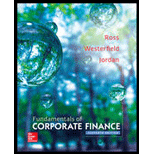
Concept explainers
Case summary:
Company P manufacturing is the manufacturer of cardboard boxes. The company decided to put all its receivables in one shoebox and all payables in others. Due this disorganized system, the company employed Person X. The company has a cash balance of $240,000 and planning to purchase a new box folding in the fourth quarter at a cost of $445,000. The purchase of machinery is in cash mode because of offered discounts. It needs to maintain minimum cash balance of $100,000.
Characters in the case:
- Company P: The manufacturer
- Person X: The new employee
To determine: The cash balance and short term financial plans of P manufacturers.
Introduction:
Cash budget is the numerical expression of cash inflows and outflows of the company during a specific period.
Explanation of Solution
Adequate information:
The Company’s sales during the four quarters are $1,240,000, $1, 370, 000, $1,450,000. The projected sales for Q1 are $1,290,000 and accounts receivables period of 53 days and accounts receivables amounts to $630,000 and 20% of accounts receivables are irrecoverable,
P manufacturing orders 50 percent of next quarter's projected gross sales in the current quarter, and suppliers are paid in 42 days. Wages, taxes, and other costs are 30% of gross sales. Interest is $130,000 and the bank pays 1.5% on short-term borrowings and 1% on deposits.
When the P Company decides to offer a discount of
Compute the net sales after discount:
Determine the cash balance when the company maintains minimum cash balance of $100,000:
Note: Since the sale value is reduced and the accounts receivables reduced to 36 days, the cash balance will be calculated on the reduced sale value.
Compute the net
| A/R at beginning of Qcollected | $504,000.00 | $494,016.00 | $521,904.00 | $545,808.00 |
| Sales collection incurrent Q | $741,024.00 | $782,856.00 | $818,712.00 | $866,520.00 |
| Purchases last Q paidthis Q | –$289,333.33 | –$305,666.67 | –$319,666.67 | –$338,333.33 |
| Purchase for next Q paidthis Q | –$349,333.33 | –$365,333.33 | –$386,666.67 | –$344,000.00 |
| Expenses | –$372,000.00 | –$393,000.00 | –$411,000.00 | –$435,000.00 |
| Interest and dividends | –$130,000.00 | –$130,000.00 | –$130,000.00 | –$130,000.00 |
| Outlay | –$445,000.00 | |||
| Net cash inflow | $104,357.33 | $82,872.00 | $93,282.67 | –$280,005.33 |
Working notes:
A/R at beginning of Q collected:
Q1 0.80 of current sales and remaining quarters be
Accounts receivable from current quarter sales:
Q1=
Purchases last Q paid this Q :
Purchase for next Q paid this Q:
Note: Refer excel for above cash budget calculation
Compute the net cash balance of each quarter:
| Particulars | Q1 | Q2 | Q3 | Q4 |
| Beginning cash balance | $240,000.00 | $344,357.33 | $427,229.33 | $520,512.00 |
| Net cash inflow | $104,357.33 | $82,872.00 | $93,282.67 | ($280,005.33) |
| Ending cash balance | $344,357.33 | $427,229.33 | $520,512.00 | $240,506.67 |
| Minimum cash balance | $100,000.00 | $100,000.00 | $100,000.00 | $100,000.00 |
| Cumulative surplus(deficit) | $244,357.33 | $327,229.33 | $420,512.00 | $140,506.67 |
Compute short-term financial plan:
| Particulars | Q1 | Q2 | Q3 | Q4 |
| Target cash balance | $100,000.00 | $100,000.00 | $100,000.00 | $100,000.00 |
| Net cash inflow | $104,357.33 | $82,872.00 | $93,282.67 | –$280,005.33 |
| New short-term investments | –$105,757.33 | –$85,329.57 | –$96,593.54 | 0 |
| Income on short-terminvestments (WN:1) | $1,400.00 | $2,457.57 | $3,310.87 | $4,276.80 |
| Short-term investments sold | $0 | $0 | $0 | $275,728.53 |
| New short-term borrowing | $0 | $0 | $0 | $0 |
| Interest on short-term borrowing | $0 | $0 | $0 | $0 |
| Short-term borrowing repaid | $0 | $0 | $0 | $0 |
| Ending cash balance | $100,000.00 | $100,000.00 | $100,000.00 | $100,000.00 |
| Minimum cash balance | –$100,000.00 | –$100,000.00 | –$100,000.00 | –$100,000.00 |
| Cumulative surplus (deficit) | $0 | $0 | $0 | $0 |
| Beginning short-term investments | $140,000.00 | $245,757.33 | $331,086.91 | $427,680.44 |
| Ending short-term investments(WN:2) | $245,757.33 | $331,086.91 | $427,680.44 | $151,951.91 |
| Beginning short-term debt | $0 | $0 | $0 | $0 |
| Ending short-term debt | $0 | $0 | $0 | $0 |
Working notes: 1
Compute interest on each quarter and net cash cost:
| Quarter | Excess funds | Interestrate | Interest paid |
| (or received) | |||
| 1 | $140,000 | 0.01 | $1,400 |
| 2 | $245,757 | 0.01 | $2,458 |
| 3 | $331,086.91 | 0.01 | $3,310.87 |
| 4 | $427,680.44 | 0.01 | $4,276.80 |
| Net cashcost | $11,445 |
Working notes: 2
| Q1 | Q2 | Q3 | Q4 |
| $140,000 | $245,757.33 | $331,086.90 | $427680.44 |
| $105,757.33 | $85,329.57 | $96,593.54 | ($275,728.53) |
| $245,757.33 | $331,086.90 | $427,680.44 | $151,951.91 |
Hence, the net cash cost is $11,445.
To determine: The effective annual rate
Compute the effective interest rate:
Hence, the effective annual rate is 13.01%.
Want to see more full solutions like this?
Chapter 18 Solutions
Fundamentals of Corporate Finance
 Managerial Accounting: The Cornerstone of Busines...AccountingISBN:9781337115773Author:Maryanne M. Mowen, Don R. Hansen, Dan L. HeitgerPublisher:Cengage Learning
Managerial Accounting: The Cornerstone of Busines...AccountingISBN:9781337115773Author:Maryanne M. Mowen, Don R. Hansen, Dan L. HeitgerPublisher:Cengage Learning
